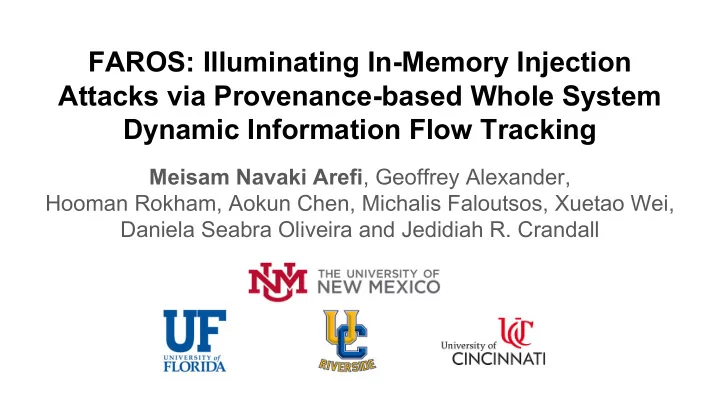

FAROS: Illuminating In-Memory Injection Attacks via Provenance-based Whole System Dynamic Information Flow Tracking Meisam Navaki Arefi , Geoffrey Alexander, Hooman Rokham, Aokun Chen, Michalis Faloutsos, Xuetao Wei, Daniela Seabra Oliveira and Jedidiah R. Crandall
Problem ● In-memory Injection attacks. ● They are becoming more and more common. ● We built a reverse engineering tool to flag them and give analysts the information they need to reverse engineer such malware. 2 ● An analyst needs visibly into memory throughout the execution.
In-Memory Injection Attack ● Operates only on memory ● Acts very stealthy ● Hard to detect 3 ● An analyst needs visibly into memory throughout the execution.
Threat Model ● Reflective DLL injection ● Process hollowing/replacement ● Code/process injection 4
Threat Model - Reflective DLL Injection ● Reflective DLL injection refers to loading a DLL from memory rather than from disk. ● Windows doesn’t have such loading function. ● Write your own load function: Omitting some of the things Windows normally does, e.g. registering the DLL as a loaded module. 5
Threat Model - Process Hollowing ● Start a process in a suspended state. ● Replace the process image with a malicious one. ● Run the process. ● Easy! 6
Threat Model - Code Injection ● Write the malicious code directly to the address space of the target process. ● Have the target process run the code. ● Easy! 7
Motivation ● Current malware analysis solutions, e.g. CuckooBox and memory forensics tools, are no match. ● An analyst needs visibility into memory throughout the execution to flag such attacks. ● Question: ○ How the attack was conducted? ○ What is the source of the attack? ○ ... 8
Dynamic Information Flow Tracking (DIFT) ● Makes systems transparent for attack detection, enforcement of security policies and forensics* *Suh et al. 2004, Minos (Crandall and Chong 2004), TaintCheck (Newsome and Song 2005), and Vigilante (Costa et al. 2004) 9
DIFT - How? I. Introduce the tags/taints II. Propagate the tags III. Check the status of tags 10
Shadow Memory 11
DIFT Example 12
DIFT Example 13
DIFT Example 14
DIFT Example 15
DIFT Example 16
DIFT Example 17
Provenance List ● Each byte could have a list of tags (provenance list). A provenance list for a specific byte 18
Tag Confluence ● Two or more tags of different types can “come together”. 19
Tag Confluence ● A bytes comes in from the network and then moves to the physical memory. 20
Tag Confluence ● Process #1 accesses that byte. 21
Flagging Policy via Provenance-based DIFT Data coming in from the network ( Netflow tag ) SHOULD NOT “come together” with linking/loading data exported by the kernel ( export table tag ). That shouldn’t happen under normal circumstances! 22
Flagging Policy via Provenance-based DIFT ● Tag confluence heuristic: 23
System Architecture 24
Results - Reflective DLL Injection 25
Results - Reflective DLL Injection 26
Comparison with CuckooBox ● Most popular open-source malware analysis system. ● We tested CuckooBox on in-memory injection attacks. ● CuckooBox (along with malfind and Volatility plugins) provided limited visibility into these attacks. ● With CuckooBox, we are blind as to how the attack was conducted. 27
True/False Positive Analysis ● Tested against 6 memory injection attacks and successfully flagged them all. ● Tested against 90 non-injecting malware samples and 14 benign software from various categories. ○ FAROS presented a very low false positive rate of 2% . 28
Performance Evaluation ● Performance is not a priority for FAROS. ● Focused on providing a low false positive rate. ● FAROS’ slowdown is 56X compared to QEMU. 29
Conclusions ● Presented FAROS, a DIFT-based reverse engineering tool, which can illuminate in-memory injection attacks. ● Tag confluence as a promising heuristic. ● Very low false positive (2%). ● FAROS ○ can save reverse engineers substantial time and effort in practice. ○ can provide reverse engineers with valuable information about any in-memory injection attacks. ● FAROS is open source: ○ https://github.com/mnavaki/FAROS 30
Acknowledgments ● Our reviewers and our shepherd, Etienne Riviere. ● DARPA Trusted Computing Project (Grant No. FA8650-15-C-7565) and the U.S. National Science Foundation (Grant Nos. #1518523, #1518878). ● NSF disclaimer: Any opinions, findings, and conclusions or recommendations expressed in this material are those of the author and do not necessarily reflect the views of the National Science Foundation. 31
Thank you! mnavaki@unm.edu 32
Recommend
More recommend